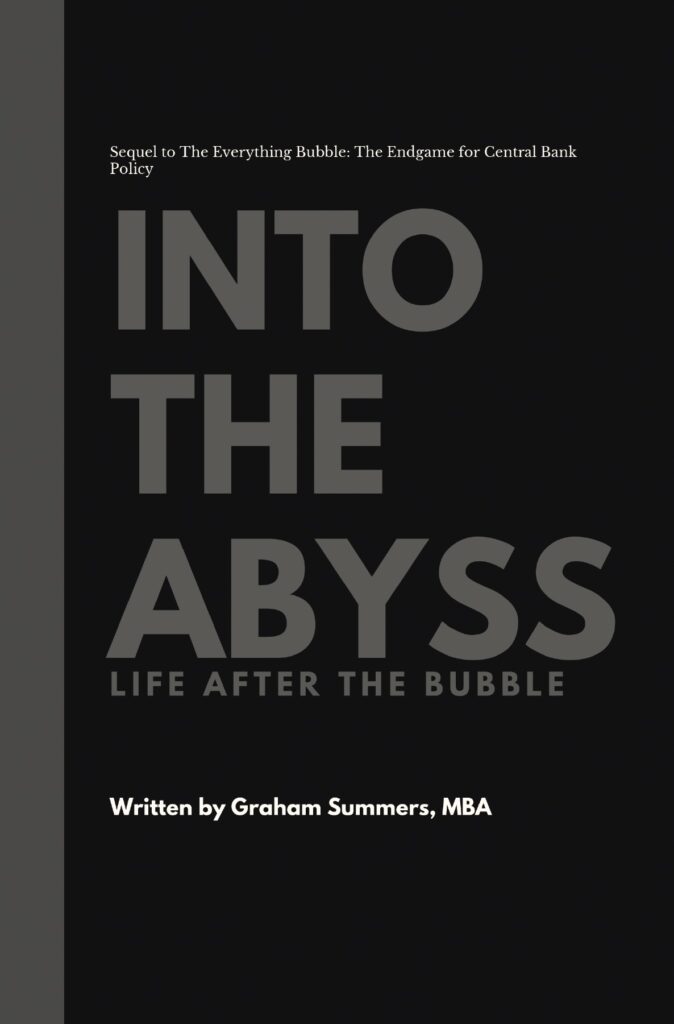THE ONLY REPORT INVESTORS NEED TO KNOW WHEN TO GET OUT OF STOCKS
LISTEN TO OUR PODCAST.
GRAHAM'S NEW BOOK WAS THE #1 NEW RELEASE IN FOUR CATEGORIES ON AMAZON
HOT TOPICS.
- 2008
- bail-ins
- bear market
- Bernanke
- big banks
- bond bubble
- bonds
- BOVESPA
- Carry Tax
- cash ban
- central banks
- China
- collapse
- contraction
- crash
- crisis
- debt
- debt crisis
- debt implosion
- deflation
- Derivatives
- economic collapse
- Federal Reserve
- inflation
- interest rates
- investing
- Jp MOrgan
- meltdown
- NIRP
- Operation Twist
- PboC
- Private wealth
- QE
- recession
- S&P 500
- slowdown
- stock market crash
- stocks
- TBTFs
- the Fed
- the market
- US Dollar
- War on cash
- Yellen
- ZIRP
Tag Archives: debt crisis
The Great Debt Crisis of Our Lifetimes is Coming!
Over the last week, we’ve warned investors that the Fed’s actions are unleashing another round of inflation in the U.S. financial system. By quick way of review. Unfortunately for Americans, the Fed isn’t the only entity that is engaged in … Continue reading
Posted in Central Bank Insanity, Inflation
Tagged biden, debt, debt crisis, inflation
Comments Off on The Great Debt Crisis of Our Lifetimes is Coming!
Bail-Ins and Frozen Accounts Are Coming to a Country Near You!
In the last 24 months, Canada, Cyprus, New Zealand, the US, the UK, and now Germany have all implemented legislation that would allow them to first FREEZE and then SEIZE bank assets during the next crisis. These moves will be … Continue reading
Posted in It's a Bull Market
Tagged bail-ins, bank holidays, crisis, debt crisis, Europe Implosion, FDIC, regulators, SEC, TBTFs
Comments Off on Bail-Ins and Frozen Accounts Are Coming to a Country Near You!
Will China’s Meltdown Trigger a Crash?
Let’s talk briefly about China. China is thought to be the great growth story of the post-2008 era. China’s economy not only bottomed before the developed world, but by most accounts, China was thought to be the engine that pulled … Continue reading
Posted in It's a Bull Market
Tagged China, collapse, contraction, crash, debt crisis, debt implosion, interest rates, meltdown, recession, slowdown
Comments Off on Will China’s Meltdown Trigger a Crash?
Fed Experts Call for NIRP… is a Physical Cash Ban Next?
More and more “experts” are calling for Negative Interest Rate Policy or NIRP. The US Federal Reserve is obsessed with market reactions to its policies. Because of this, anytime the Fed plans to announce a major change in policy, it … Continue reading
Posted in It's a Bull Market
Tagged bonds, crisis, debt crisis, Federal Reserve, the Fed, War on cash
Comments Off on Fed Experts Call for NIRP… is a Physical Cash Ban Next?
It’s Official: Central Banks Are Losing Control
For six years, the world has operated based on faith and hope that Central Banks somehow fixed the issues that caused the 2008 Crisis. All of the arguments supporting this defied common sense. A 5th grader knows that you cannot … Continue reading
Posted in It's a Bull Market
Tagged BoJ, bond bubble, bonds, debt crisis, debt implosion, ECB, interest rates, PboC, the Fed
Comments Off on It’s Official: Central Banks Are Losing Control
One by One Central Banks Are Losing Control
Since 2008, the Keynesians running global Central Banks had always suggested that there was no problem too great for them to handle. They’d promised to do “whatever it takes,” to maintain the financial system and print the world back to … Continue reading
Posted in It's a Bull Market
Tagged bond crisis, central banks, China, debt crisis, financial collapse, market alert, PboC, SNB, stock market crash, the Fed
Comments Off on One by One Central Banks Are Losing Control
The Real Reason the Fed Won’t Raise Interest Rates
Another Fed FOMC meetings has come and gone and interest rates remain at zero. The investing world is obsessed with guessing when the Fed will raise rates and by how much. The Fed has been dangling the “rate hike” over … Continue reading
Posted in It's a Bull Market
Tagged big banks, bond bubble, debt crisis, FOMC, interest rates, Janet Yellen, stocks, TBTFs, the Fed
Comments Off on The Real Reason the Fed Won’t Raise Interest Rates
Why What’s About to Begin Will Dwarf 2008
Earlier this week I outlined how the next Crash will play out. Today we’ll assess why this Crisis will be worse than the 2008 Crisis. By way of explanation, let’s consider how the current monetary system works… The current global … Continue reading
Posted in It's a Bull Market
Tagged 2008, bonds, crisis, debt crisis, emerging market meltdown, implosion, interest rates, the Fed, US Dollar
Comments Off on Why What’s About to Begin Will Dwarf 2008
Is the Treasury Preparing For a Systemic Event?
Behind the veneer of “all is well” being promoted by both world Governments and the Mainstream Media, the political elite have begun implementing legislation that will permit them to freeze accounts and use your savings to prop up insolvent banks. … Continue reading
Posted in It's a Bull Market
Tagged bail-ins, bonds, Cyprus bank, debt crisis, the Fed, Treasury
Comments Off on Is the Treasury Preparing For a Systemic Event?




